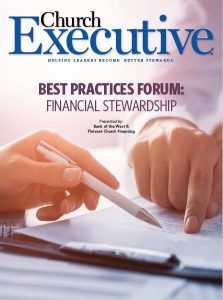

By Dan Mikes
You’ve been offering two or three weekend worship services for quite a while, you are regularly filling more than 80 percent of the seats available in your worship facility, and you are at maximum capacity in the children’s space.
Understandably, your leadership team has decided it is time to expand.
As the business administrator or executive pastor, you have been tasked with the responsibility to initiate contact with prospective financial partners, and secure the best possible terms for a comprehensive banking relationship. This is your first foray into such a task; naturally, you’re wondering what the lender will be looking for.
Each lender might have a slightly different approach to underwriting your credit needs and, consequently, a somewhat unique list of loan application requirements. You should be prepared to present a high-level summary of your circumstances. You will want to offer some perspective regarding your current needs and plan to address them, how your institution is well positioned to borrow, and your expectations in a banking relationship.
Experienced ministry lenders will readily understand that your growth will begin to level off once your attendance levels bump up against 80 percent of the seating capacity in your worship facility. They also know there is a limit to the number of worship service time slots that can be added while still allowing sufficient time between services for congregants to get into and out of the parking lot.
Multi-site might make more sense
While on-site physical plant expansion continues to be a common solution, many lenders have also become very familiar with addressing growth via a multi-site strategy. Be prepared to summarize your growth needs and your leadership team’s thought processes leading to your chosen course of action.
Before approaching lenders, try to develop some preliminary estimates of cost for construction, land or facility acquisition. It is best not to dive too deeply into incurring costs for architectural plans and construction bids before talking to an experienced ministry lender about borrowing capacity. Ideally, begin your conversations with lenders four to six months in advance of your desired project start date.
“Financial institutions typically set their loan rates based on a relationship yield. Said another way, you might be offered more favorable loan terms if you are willing to place your deposit relationship, your commercial credit card, and your merchant processing business with a single institution.”
Determining borrowing capacity
A lender with an established credit template for religious institutions might be able to guide you through identifying your borrowing capacity. In my experience, your borrowing capacity might be limited to a multiple of your annual general (undesignated) contributions, and a couple of examples of common multiples include three or 3.25.
Debt capacity is typically further subject to analysis of your “cash-available-for-debt-service” in the prior year or two. Your historic free cash flow might not necessarily need to be strong enough to cover the annual cost of the contemplated debt; but when looking at the past two years, the lender might want to see some progress toward that end, and you might need to be prepared to discuss how any shortfall could be addressed. An example of one solution could be to show a plan to orchestrate a multi-year capital pledge campaign where pledges are being collected for three to six months prior to the loan closing.
Consider consolidation

As you prepare to weigh one lender’s terms and conditions against another, you should anticipate the need to consider all facets of your banking relationship. Financial institutions typically set their loan rates based on a relationship yield. Said another way, you might be offered more favorable loan terms if you are willing to place your deposit relationship, your commercial credit card, and your merchant processing business with a single institution.
You might want to consider potential unanticipated consequences of choosing a non-bank lender. These institutions might offer loans but do not provide depository and cash management solutions, commercial credit cards, merchant processing, and other banking services. In recent years, regulators have increased their focus on bank processes related to “Customer Due Diligence” (CDD) and “Know Your Customer.” Financial institutions can incur significant ongoing costs associated with these processes which support compliance with regulations such as Anti-Money Laundering, The Bank Secrecy Act, and monitoring transactions with Major Sanctioned Countries. In some cases, financial institutions have decided that the cost of compliance should be weighed against the customer relationship yield.
In a worst-case scenario, if you borrow from an institution which only offers loans, you might eventually find it more difficult to secure and maintain favorable terms on other standalone banking services. Consolidating your loan and other banking services at a single institution might enable you to avoid operational disruption down the road.
The best advice is to look for an experienced religious institution banker. An experienced lender will understand that physical plant expansion projects are not a part of your core job description, and they will likely be happy to assist in making the process go more smoothly for you.
Dan Mikes is Executive Vice President and National Manager of the Religious Institution Division, Bank of the West in San Ramon, California. The views and opinions expressed in this article are those of the author and do not necessarily reflect the official policy or position of Bank of the West.


